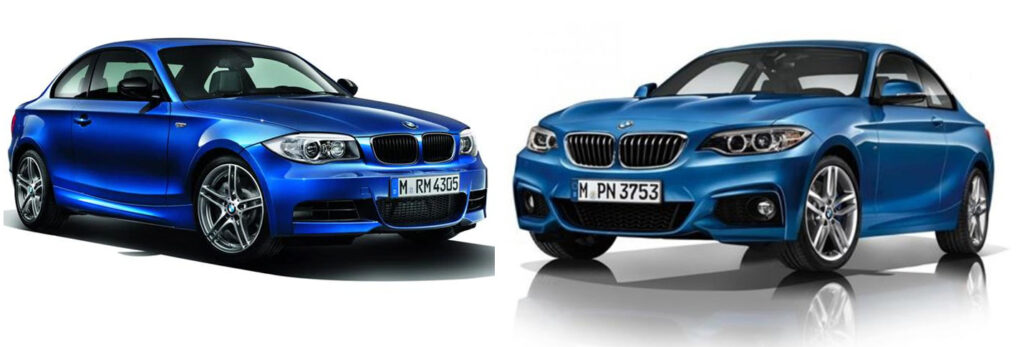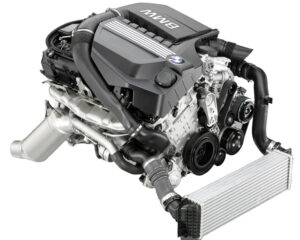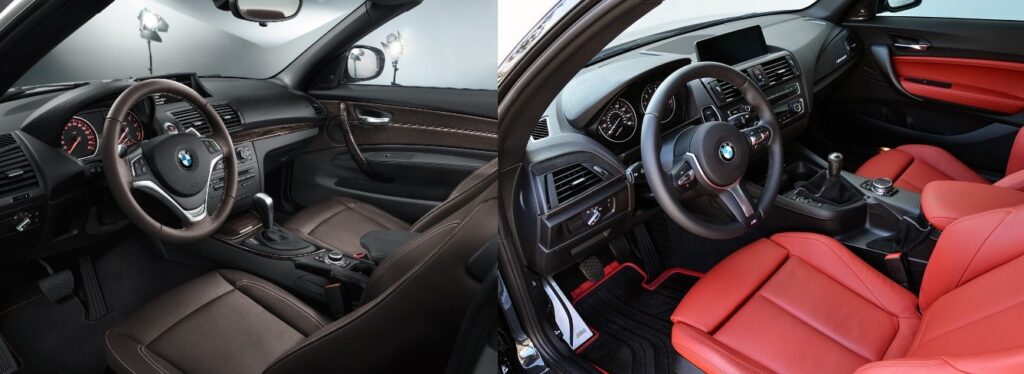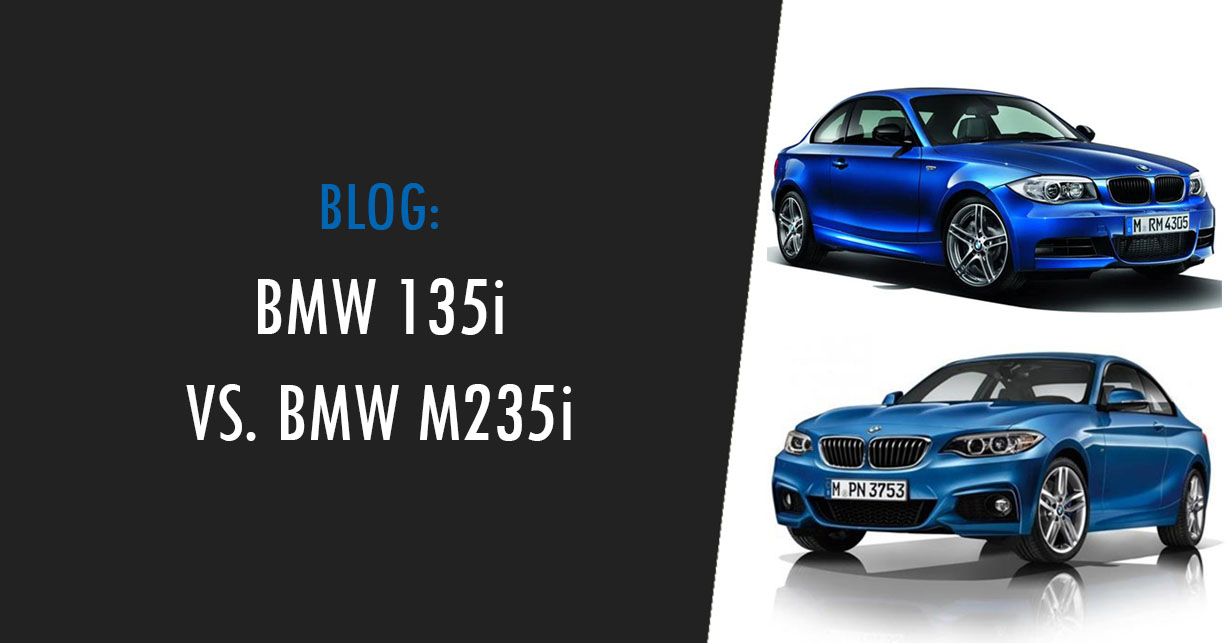The BMW 1-Series and 2-Series represent a range of BMW subcompact cars designed to offer driving dynamics and luxury in a small and sensible package. The BMW E82 135i 1-Series first came out for the 2007 model year and was offered until 2013 when it was succeeded by the F22 M235i. An M135i was never offered in North America.
The BMW M235i 2-Series was introduced for the 2014 model year and is a compact 2-door coupe that comes with the BMW M-performance treatment straight from the factory. The F22 generation represents the first iteration of the BMW 2-Series In this article. We will compare these two compact and sporty compact couples so you can decide which one suits your needs best.

BMW E82 135i vs. F22 M235i: Overview
| BMW E82 135i | BMW F22 M235i | |
|---|---|---|
| Stock power & torque | 302hp and 295lb-ft of torque | 322hp and 332lb-ft of torque |
| Length | 4360 mm (171.65 in) | 4,432 mm (174.5 in) |
| Width | 1748 mm (68.82 in) | 1,774 mm (69.8 in) |
| Height | 1408mm (55.9 in) | 1,408 mm (55.8 in) |
| Weight | 3450 lbs (RWD automatic) | 3406 lbs (RWD automatic) |
| Years produced | 2007 – 2013 | 2014-2016 |
| 0-60mph acceleration | 4.8 seconds | 4.3 seconds |
BMW 135i vs. M235i: Engine & Power
Both of these BMWs use a turbocharged inline-6 engine, but there are quite a few nuances between them. For starters, the 2007-2010 135i uses BMWs older N54 engine while the 2010-2013 LCI 135i uses the newer N55 engine, both of which offer 302hp and 295lb-ft of torque. The BMW M235i comes with a M Performance N55 engine with 322hp and 332lb-ft of torque, borrowing some improvements from the M2.

The N54 engine in the older 135i produces maximum horsepower at 5,800rpm while maximum torque is between 1,400rpm and 5,000rpm. The comparably newer N55 in the 135i offers maximum horsepower between 5,700rpm and 5,800rpm while maximum torque is available between 1,200rpm and 5,000rpm.
The M235i is the faster car due to its improved N55
The N55 in the M235i has an even wider power band as it pushes maximum power between 4,505rpm and 6,000rpm while torque is maxed out between 1,300rpm and 4,500rpm. The N55 in the M235i likes to rev the most and is at home at high RPMs while the N55 in the E82 135i is best when it comes to low-down torque. Compared to the N54 version of the 135i, the N55 135i is more responsive and much more reliable.
A 135i can do 0-60 mph in 4.7 seconds while the M235i can also speed from 0 to 60 mph in just 4.3 seconds according to Car and Driver.
BMW 135i vs. M235i: Drivetrain
The drivetrain department also comes with its own set of differences, and the most notable one is the fact that you can get the M235i with xDrive or RWD while the 135i is strictly a RWD car. This gives the M235i more control while exiting corners while also giving you an advantage during adverse weather conditions.
The 135i comes with three different transmission options, a 6-speed auto, a 7-speed DCT, or a 6-speed manual. The 7-speed DCT is the fastest-shifting one out of the bunch but will also require more frequent maintenance. We recommend opting for the 6-speed manual.
The M235i is available with RWD or AWD and has better transmission options
The M235i on the other hand is available with the amazing ZF 8HP 8-speed automatic, but also with a 6-speed manual. Both are great transmissions. Oddly enough we recommend the 8-speed auto; it’s almost as fast-shifting as the DCT but much smoother. The N55 and the ZF 8HP is a match made in heaven. Another
BMW 135i vs. M235i: Driving and Handling
The E82 135i was initially launched for the 2007 model year which means that it is much older than the F22. This comes with perks as the E82 135i still relies on hydraulic power steering and has a smaller chassis.
On the other hand, the M235i uses electric power steering which does not feel as connected to the road. Those coming from an E-chassis car will immediately notice how numb the steering feel is on the M235i
The 135i has much better steering feedback but is heavier than the M235i
The most notable handling differences between these two compact BMWs are the weight and the structural rigidity. The M235i is almost 50 pounds lighter and features a more rigid chassis. The body also flexes a lot more for the very same reason where the M235i is much more poised and controlled.
Despite the lackluster steering feel and increased size, the M235i will outhandle the 135i in almost all scenarios.
BMW 135i vs. M235i: Reliability
The E82 generation of the 1-Series has had its fair share of issues over the years which are only worsened by the fact that some of these are now more than 15 years old. The main reason why older E82s can’t seem to hold up nicely is due to the N54 engine which is considerably less reliable than the N55.
M235i has higher reliability than the 135i
However, even the E82 N55 135i tends to become more and more problematic as it ages. The M235i is more special in the eyes of most BMW enthusiasts which means that most people take better care of it. The M235i is the more reliable of the two, especially in the automatic transmission department where the ZF 8-speed is widely regarded as one of the best automatic transmissions out there while the 7-speed DCT tends to be maintenance-heavy.
BMW 135i vs. M235i: Exterior Design
The E82 135i isn’t the most attractive generation of the BMW 1-Series while the M235i 2-Series looks sharp and sleek in comparison. However, the two biggest differences between the aesthetic identity of these two cars are the fact that the E82 135i is very small while the F22 M235i looks considerable bigger.
The former makes the E82 look more cruiser-like and fairly un-performance-looking while the latter makes the M235i more aggressive, more purposeful, and more in line with what you typically expect to see from a compact BMW coupe.
BMW 135i vs. M235i: Interior & Comfort

The age difference between these two is even more obvious in the interior where the M235i offers a much-improved interior that resembles the one you’d typically find in an M-Sport BMW F30 series of cars. The E82 135i can also be way too cramped which is why those looking for space should focus on the M235i.
Granted, the M235i is no full-size sedan, but it does represent a nice in-between the smaller 1-Series and the larger 3-Series. BMW combined certain aspects of the 3-Series with the 1-Series which resulted in a better-looking interior, a bit more space, and a significantly higher feeling of luxury and technology.
BMW 135i vs. M235i: Price and Value
As far bang-for-buck is concerned, you can’t beat an N55 135i with a manual gearbox, it offers a similar experience to the F20 generation of the 2-Series, but at a much lower price. The M235i is a more expensive car than the 135i, and although it beats it in terms of raw performance, the hydraulic steering rack of the 135i provides the driver steering feedback and road feel that the M235i can’t match.
Final thoughts
We can all agree that the F22 M235i is superior to the 135i on paper. It is more powerful, it is lighter, it has better handling, is more reliable, and the interior is improved in every way.
The E82 135i offers a more connected driving experience at a really good price, and a manual 135i is an excellent “analog” BMW and is fairly reliable and trouble-free if you opt for an N55 model. We prefer the 135i due to its great value proposition and growing uniqueness.

